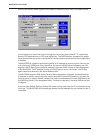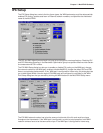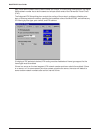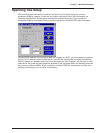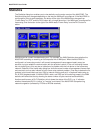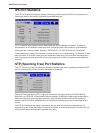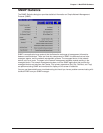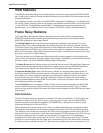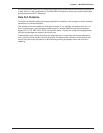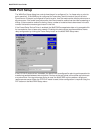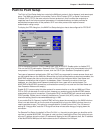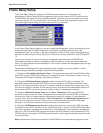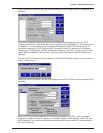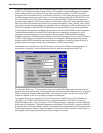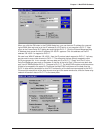
38
MultiFRAD II User Guide
WAN Statistics
The WAN Port Statistics dialog box provides statistical information regarding the MultiFRAD’s WAN
port, including the number of packets transmitted/received, and to transmit, and the number of bytes
transmitted/received.
This dialog box monitors the traffic on the MultiFRAD’s composite link (WAN) port. The Statistics that
fall into the “Others” category relate to the physical layer between the MultiFRAD and the link device;
i.e. the CSU/DSU. These statistics can be helpful in troubleshooting suspected problems in the
physical layer; i.e., the WAN port itself, the link device (CSU/DSU), and any associated cabling.
Frame Relay Statistics
The Frame Relay Management Statistics dialog box can be a useful tool for troubleshooting
MultiFRAD installations and monitoring the performance of active links, and checking that the
MultiFRAD is talking to the provider’s switch.
The Polling Details section lists the various management frames sent and received. For every
Status Enquiry Sent, a Status Response should be received from the network. Likewise, for every
Full Status Enquiry Sent, there should be one Full Status Response received. The two status enquiry
types are used by the FRAD to verify that the frame relay network is operational, and to determine
which DLCIs are active. Under default settings a status enquiry is sent every ten seconds, and every
sixth enquiry will be a Full Status Enquiry.
The Enquiries Sent and the Responses Received should increment together, and should be equal
under normal circumstances. Any gap between them reflects a breakdown in communication with the
provider’s switch, and will be reflected as Missed Status Responses.
The Status Errors section lists the number of errors that have occurred. A Missed Status Response
means the frame relay network did not respond to a status enquiry from the MultiFRAD before the
next status enquiry was sent (by default there are 10 seconds between status enquiries).
A Sequence Number Error means the sequence numbers in a received status response did not
match what the MultiFRAD expected based on its Status Enquiry. Basically, the Status Enquiry has
two numbers (or counts), and one should be incremented by the network and then both numbers
should be returned to the FRAD in the Status Response. Sequence Number Errors also reflect
missing packets between the MultiFRAD and the switch, but are not a cause for alarm unless they
are incrementing rapidly and steadily.
The Link Details section records the number of times the frame relay link between the MultiFRAD
and the network has gone up (become active) or gone down (become inactive). The Link Details
provide a more general picture of the status of communication between the MultiFRAD and the frame
relay network.
DLCI Statistics
The DLCI Statistics dialog box shows the individual DLCI status and statistics. This information can
be helpful in determining if the DLCI is active, if it is going up and down, and if the MultiFRAD is
experiencing frame relay network congestion (FECNs/BECNs). It also gives an indication of the
momentary throughput on individual DLCIs.
When troubleshooting a frame relay circuit, once it has been established that management frames
are being sent and received, the next step is to determine whether the DLCIs are becoming active.
This dialog box will provide that information. A FRAD needs to be present at both ends for the DLCI
to be active. Keep in mind that the frame relay network tells the FRAD the status of the PVC with one
of its status responses. But the network will not say the PVC is active until it has established
management communication at both ends of the PVC. If the FRADs at both ends of the PVC show
that they are communicating with the frame relay network and the DLCI still shows active, and there
is a communication problem over that PVC, there may be a problem with your service provider. If all



